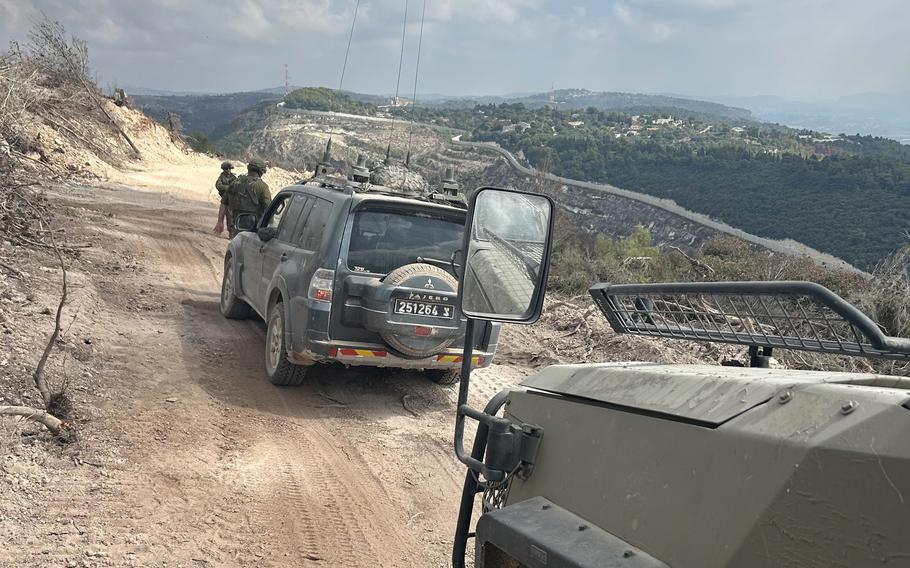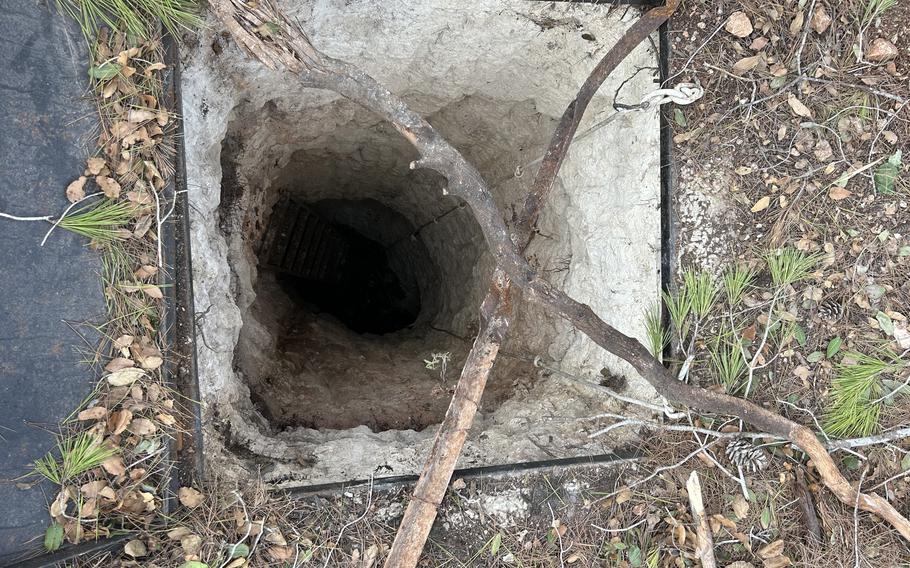
Israeli troops operate in Lebanese territory north of the border. The concrete border that divides Lebanon from Israel is visible in the valley below. (Steve Hendrix/The Washington Post)
SOUTHERN LEBANON — In a stretch of scrubby frontier less than 1,000 feet north of the concrete wall that divides Lebanon from Israel, two Israeli commanders stood in enemy territory and peered into a carved stone shaft. The hole, large enough for a man with a backpack, descended for about 25 feet before giving way to a horizontal opening, just visible in the darkness.
A few yards away, a square metal hatch revealed a similar entryway - two among dozens of interconnected Hezbollah shafts and tunnels, along with caches of antitank missiles, explosives and body armor, that Israeli commanders say their soldiers have discovered here since storming across the Lebanese border on Sept. 30.
Down the steep slope, on the other side of the wall, sat the mostly empty Israeli town of Shlomi, evacuated more than a year ago as Hezbollah fighters began launching rockets at Israel in solidarity with Hamas in Gaza.
The Israel Defense Forces brought a small group of journalists into the southwestern corner of Lebanon on Sunday to show what commanders described as extensive and entrenched militant infrastructure.
“You can just imagine if something like what happened on Oct. 7 happened here,” said Gen. Yiftach Norkin, the commander, by the shaft. “In Hezbollah, we are not facing a terror group, but a terror army.”
The Washington Post was not able to independently confirm that the tunnel shafts, military gear and firing positions displayed by the IDF were Hezbollah assets. Most of the weapons described had already been removed, and reporters were not allowed to leave the company of Israeli soldiers. The Post agreed not to disclose the location or identities of Israeli troops in this story, with the exception of Norkin. The text and images were not reviewed by the Israeli military.
From the near distance came the sounds of war - explosions and the hum of drones and the occasional rattle of automatic weapons - as Israeli and Hezbollah forces clashed up and down the length of the battered border region.

An excavated shaft that the IDF said was one of dozens of Hezbollah shafts and tunnels, many of them interconnected, they have uncovered on the Lebanese side of the border. (Steve Hendrix/The Washington Post)
Southern Lebanon and northern Israel were already conflict zones before the recent descent into all-out war. Hezbollah and the Israeli military traded fire for more than 11 months, displacing tens of thousands of civilians on both sides of the border. Twenty-eight Israeli civilians and more than 40 Israeli forces have been killed by Hezbollah attacks since last October, the IDF says.
Israel broke the cross-border stalemate last month with a succession of military and intelligence operations - blowing up Hezbollah’s electronic devices, killing the group’s longtime leader, Hasan Nasrallah, dramatically expanding airstrikes across the country and sending troops into the south for the first time since 2006.
The toll has been devastating in Lebanon, where at least 1,696 people have been killed since Sept. 16, according to the country’s ministry of health, which does not distinguish between civilians and combatants but says hundreds of women and children are among the dead. There have been 16 attacks on Lebanon’s health care system over the same period, the World Health Organization said last week, killing 65 health workers.
Israeli leaders say the assault will continue until Hezbollah fighters have been pushed back from the south and displaced families in the north can safely return to their homes. Had they not sent ground forces into Lebanon, Israeli intelligence services assessed that the war of attrition along the border could have stretched for years, according to an Israeli official, speaking on the condition of anonymity to discuss classified findings.
Now, Israeli units are clearing trees and brush from the steep Lebanese slopes, hoping to remove the threat of well-concealed Hezbollah fighters breaching the border.
“We knew about [Hezbollah’s] plans, but I am surprised at how much we found here,” Norkin said.
Despite its heavy losses, Hezbollah has demonstrated it can still strike deep inside Israel. The group claimed credit Sunday for a drone attack on Binyamina, 25 miles south of Haifa, which it said targeted a military base. At least four soldiers were killed, the IDF said, and dozens of others wounded.
Israeli political and military leaders blame the U.N. Interim Force in Lebanon, or UNIFIL, for allowing Hezbollah to build up its arsenal within view of Israeli neighborhoods.
Norkin pointed to the tower of a UNIFIL base, about 65 yards away from one of the shafts, wondering how the soldiers inside could have missed the construction of tunnels nearby.
“UNIFIL reports all violations that we observe,” said Andrea Tenenti, UNIFIL’s spokesman in Beirut. “If we had seen a tunnel, we would have reported it to the Security Council,” he added, saying U.N. forces lack “thermal imaging sensors or ground penetrating radar to detect underground activity.”
Tensions between Israel and the United Nations soared over the last week after UNIFIL rebuffed Israeli demands to withdraw from the border area. Since Thursday, the IDF has opened fire on several UNIFIL positions, injuring five peacekeepers from the multinational force. Israeli officials, and the commanders escorting journalists Sunday, have denied U.N. claims that they are targeting its troops.
“We are not at war with UNIFIL,” Norkin said. “I have told my soldiers that.” The injuries suffered by the peacekeepers were mistakes attributable to Hezbollah operating so near to U.N. facilities and personnel, he said.
On Sunday, according to UNIFIL, two IDF tanks destroyed the main gate and “forcibly entered” a U.N. position near the Lebanese village of Ramyeh. “Any deliberate attack on peacekeepers is a grave violation of international humanitarian law,” UNIFIL said in a statement.
The IDF said the incident happened after its forces came under fire, and that the tank was trying to evacuate injured soldiers when it backed into the post.
In a video posted online Sunday, Israeli Prime Minister Benjamin Netanyahu appealed directly to the U.N. Secretary General to remove the peacekeepers from southern Lebanon. “Your refusal to evacuate UNIFIL soldiers has turned them into hostages of Hezbollah,” he said.
Closer to the Lebanese coastline, Israeli troops led journalists on Sunday into a dense forest path. Just inside, disguised by tree cover, was a two-person barrier of sandbags and stone-filled baskets. It was a firing post, the IDF said, that had been used all year to shoot at Israeli cameras and troops.
The path was one of dozens running north-south through the forest and emerging near the border, according to the IDF. Commanders said they were used to funnel Hezbollah fighters by the hundreds into the open stretch along the border wall.
A hundred yards deeper, a man-made cave was buried in forest mulch. Inside were crates that once held missiles, the IDF said. A plastic bag of rifle bullets and bins filled with body armor were piled nearby. Twin racks held four canisters each of what looked like paint cans packed with gray material - explosives, now defused, designed to quickly attach to the barrier wall and blow a breach in it, soldiers said.
One of the Israeli officers inside of Lebanon lives in one of the border towns just to the south. He has been watching the threat build up on these slopes for years, he said.
“Could the U.N. not see what’s going on here?” asked Ariel, speaking on the condition he only be identified by his first name in compliance with military protocol. He and his fellow soldiers say they will remain here until they have scrubbed the strip of weapons, fighters and vegetation. How the Israeli military will keep the border zone clear without occupying Lebanon indefinitely is unclear.
It is up to the diplomats and politicians to come up with a long-term solution, the soldiers said. But they are pushing on.
“My family lives right down there,” said Ariel. “We can’t let [Hezbollah] come back.”
Abbie Cheeseman in Beirut and Meg Kelly in New York contributed to this report.